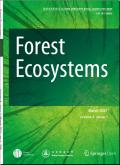欧亚河狸的啃食活动对意大利三条河流河岸森林结构的影响
IF 4.4
1区 农林科学
Q1 FORESTRY
引用次数: 0
摘要
欧亚海狸(Castor fiber Linnaeus, 1758)可以被认为是水文生态系统工程师,因为它通过建筑活动和摄食行为塑造了环境特征。尽管已有研究报道了海狸对多类群生物多样性和森林更新的影响,但对海狸直接活动于树木后林分结构演变的研究还很缺乏。这是预测恢复结果和建议良好的造林和管理做法以维持特定森林条件的关键主题。具体而言,考虑河流变异性、与河岸的距离和河狸啃食活动强度,研究林分结构和树种多样性的变化。欧亚海狸最近才重新在经分析的三条地中海河流中定居,但林分结构似乎已经受到该物种的严重影响。由于大多数最年轻和/或较小的树木被完全砍伐,树木的数量减少,林分高度的平均直径增加。在受强烈影响的林分和靠近河岸的森林部分,可以发现最强烈的结构变化。对大多数多样性指数没有显著影响,可能是由于每个林分的树层组成最初都是均匀的,以及地点内海狸饮食的种类有限。未来次生树梢的再生以及海狸啃咬活动强度随时间和空间的变化,会进一步导致中长期结构参数和木本物种多样性的变化。因此,进一步监测长期影响将是至关重要的,因为结构变化会对河岸生态系统功能产生重大影响。本文章由计算机程序翻译,如有差异,请以英文原文为准。

The influence of the Eurasian beaver's gnawing activity on the structure of riparian forests in three Italian rivers
The Eurasian beaver (Castor fiber Linnaeus, 1758) can be considered a hydrological ecosystem engineer as it shapes environmental characteristics through its building activities and feeding behaviour. Even if several studies have so far reported beaver impact on multi-taxon biodiversity and forest regeneration, there is a lack of research on forest stand structure evolution following beaver direct activity on trees. This represents a pivotal topic for predicting restoration outcomes and reccommending sound silvicultural and management practices to maintain specific forest conditions. Specifically, the study aims at investigating forest stand structure and tree species diversity changes considering river variability, distance from the riverbank and beaver's gnawing activity intensity. The Eurasian beaver is only recently recolonising the three analysed Mediterranean rivers, but stand structure seems to be already significantly impacted by the species. The number of trees was reduced, increasing mean diameter at breast height at stand level, as most of the youngest and/or smaller trees are entirely cut down. Strongest structural variations can be detected in intensively impacted stands and in the forest portions closer to the riverbank. The absence of a significant effect on most of the diversity indices is likely due to the initially homogeneous composition of the tree layer in each stand and to the limited variety of beaver's diet within the sites. Future resprouting of secondary tree shoots, as well as beaver gnawing activity changes in intensity over time and space, can further produce variations in structural parameters and woody species diversity in the medium- and long-term period. Therefore, it will be crucial to further monitor the long-term effects, as structural shifts can produce significant effects on riparian ecosystem functions.
求助全文
通过发布文献求助,成功后即可免费获取论文全文。
去求助
来源期刊

Forest Ecosystems
Environmental Science-Nature and Landscape Conservation
CiteScore
7.10
自引率
4.90%
发文量
1115
审稿时长
22 days
期刊介绍:
Forest Ecosystems is an open access, peer-reviewed journal publishing scientific communications from any discipline that can provide interesting contributions about the structure and dynamics of "natural" and "domesticated" forest ecosystems, and their services to people. The journal welcomes innovative science as well as application oriented work that will enhance understanding of woody plant communities. Very specific studies are welcome if they are part of a thematic series that provides some holistic perspective that is of general interest.
 求助内容:
求助内容: 应助结果提醒方式:
应助结果提醒方式:


